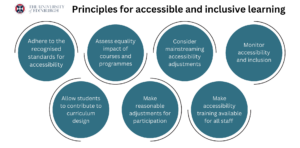Universal design, accessibility, and inclusion
What is universal design?
Universal design aims to mainstream accessibility and inclusion by designing this in from the start rather than as an afterthought. It is about ensuring that learning can be accessed by all learners, whatever their needs and backgrounds, to the greatest extent possible without adjustments needing to be made. Common examples of universal design include providing resources in a range of formats and ensuring learning materials are available in advance. The University’s Accessible and Inclusive Learning Policy includes a set of principles that guide our approach to inclusive course and programme design, which are summarised in the graphic below.

Why is it important?
With the introduction of the Equalities Act in 2010, universities and other public bodies have a statutory duty to make reasonable adjustments for people living with disabilities. More broadly, universal design is about anticipating our students’ needs and improving the overall learning experience in an inclusive and accessible way that benefits all our students. This can be applied to a range of contexts, from ensuring gender equality is built into learning and teaching, to understanding the hidden curriculum and its impacts on students from a working-class background. It also links to work taking place at the university to decolonise the curriculum and build an anti-racism movement, which you can read more about on the Decolonising and Anti-racism pages.
It is important that when designing a new course or programme, proper attention is given to writing a meaningful equity, diversity, and inclusion (EDI) statement that is specific to your course or programme for the Board of Studies process. A helpful guide for this process has been developed by W. Victoria Lee in ECA: A Quick Guide for New Course Proposers.
Furthermore, the Inclusive Curriculum content on the Institute for Academic Development webpages, developed by Vel McCune, is a great starting point for orientating yourself in the area of universal design, EDI, and accessibility and inclusion.


Comments are closed
Comments to this thread have been closed by the post author or by an administrator.